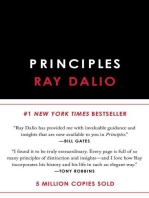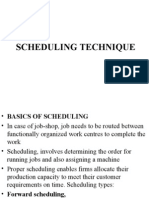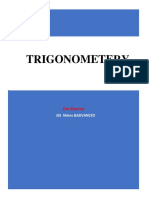GS104 - Exam I - Review
GS104 - Exam I - Review
Uploaded by
longlistCopyright:
Available Formats
GS104 - Exam I - Review
GS104 - Exam I - Review
Uploaded by
longlistOriginal Description:
Copyright
Available Formats
Share this document
Did you find this document useful?
Is this content inappropriate?
Copyright:
Available Formats
GS104 - Exam I - Review
GS104 - Exam I - Review
Uploaded by
longlistCopyright:
Available Formats
GS104 1st Test Major Topics for Review Format of the Test Multiple Choice (60 questions) Major
or Topics for Review (Chs 1-4) Motion Aristotle vs. Galileo Aristotle two kinds: Natural motion motion that is straight up or straight down Violent motion imposed motion resulting from an external push or pull Mass/Inertia G- Objects continue to move indefinitely Objects drop at the same time. Tendency of a moving body is natural. Inertia: property of things to resist change. Mass: Quantity of matter in an object. Measure of inertia or sluggishness that an object exhibits in response to any effort . Mass is greater than inertia. Smallaer mass smaller inertia Weight: amount of gravitational pull on an object proportional to mass. Mass involves how much matter an object contains. Volume involves how much space an object occupies. Density is the measure of how much mass occupies a given space. Equilibrium/Net force: Equilibirum is and object that moves at constant velocity. Two or more forces cancel at zero. Netforce: Combination of all forces that cat on an object. Changes an objects motion. Friction/Support force G- In the absence of friction, no force is necessary to keep a horizontally moving object moving. Friction: the resistive force that opposes the motion or attempted motion of an object through a fluid or past another object with which it is in contact and it is always acts in a direction to oppose motion Support force: is force that supports an object on the surface against gravity, and it is also normal force Velocity & Acceleration: Acceleration is the rate at which velocity changes with time. The change in velocity may be in magnitude, in direction, or both. Acceleration=change of velocity/time interval. Free fall: When the only force acting on a falling object is gravity Scalar vs. vector quantities: scalr has magnitude (speed), and vector has magnitude plus direction. (velocity Newtons Laws Newtons 1st/2nd/3rd Laws (be able to explain situations using all three laws) 1st. The law of inertia: Every object continues in a state of rest or of uniform speed in a straight line unless acted on by a nonzero force. 2nd. The law of acceleration: The acceleration produced by a net force on an object is directly proportional to the net force, is in the same direction as the net force, and is inversely proportional to the mass of the object Accerleration= net force/mass Smaller the force larger the mass small acceleration Large net force, mall mass large acceleration 3rd. Law of action and reaction: Whenever one object exerts a force on a second object, the second object exerts an equal and opposite force on the first. Free-Fall- An object in free fall accelerates toward Earth at 10 m/s per second. When the only force acting on a falling object is gravity, with negligible air resistance, the object is in free fall. Momentum & Energy Momentum: is inertia in motion defined as the product of mass and velocity: mv high mass high velocity -> high momentum and the higher Impulse: product of force and contact time equation: impulse = force time = Ft greater force for long time -> larger impulse Impulse = Change in momentum- decreases momentum over a longer time results in smaller force Conservation of momentum: momentum cannot change unless acted by an external force. Collisions: when objects collide in the absence of external force Elastic vs. Inelastic: is defined as a collision whereupon objects collide without permanent deformation or the generation of heat. Inelastic: is defined as a collision whereupon colliding objects become tangled or coupled together, generating heat. Energy: ability to do work Work: force applied over a distance Potential: stored energy due to position shape or state. Kinetic: defined as energy of a moving body. Work = Change in kinetic energy Conservation of energy: to save or remain unchanged Power: energy per unit time how fast work is done. Work/time interval. Machines/efficiency: ratio of input to output Sources of energy Gravity & Satellite Motion Universal Law of Gravity: Newtons Law of Universal Gravitation. Every body in the universe attracts every other body with a mutually attracting force. For 2 bodies, this force is directly proportional to the product of their masses and inversely proportional to the square of the distance separating them. Every mass pulls other mass. Inverse-square relationships: intensity of an object in inverse squares. Pull on by gravity. Weight & weightlessness- an illusion caused by the lack of support. Force or eg: free fall Projectile Motion: objects launched only under the influence of gravity Satellites: obejects that fall around an object eg. moon Circular vs. elliptical orbits: circular is around earth. Elliptical: is a path followed by a satellite. Orbital speed is 17500mph Escape Speed:The initial speed that an obeject must reach to escape gravitational influence of earth. 25000mph
You might also like
- The Subtle Art of Not Giving a F*ck: A Counterintuitive Approach to Living a Good LifeFrom EverandThe Subtle Art of Not Giving a F*ck: A Counterintuitive Approach to Living a Good LifeRating: 4 out of 5 stars4/5 (5935)
- The Gifts of Imperfection: Let Go of Who You Think You're Supposed to Be and Embrace Who You AreFrom EverandThe Gifts of Imperfection: Let Go of Who You Think You're Supposed to Be and Embrace Who You AreRating: 4 out of 5 stars4/5 (1106)
- Never Split the Difference: Negotiating As If Your Life Depended On ItFrom EverandNever Split the Difference: Negotiating As If Your Life Depended On ItRating: 4.5 out of 5 stars4.5/5 (879)
- Grit: The Power of Passion and PerseveranceFrom EverandGrit: The Power of Passion and PerseveranceRating: 4 out of 5 stars4/5 (598)
- Hidden Figures: The American Dream and the Untold Story of the Black Women Mathematicians Who Helped Win the Space RaceFrom EverandHidden Figures: The American Dream and the Untold Story of the Black Women Mathematicians Who Helped Win the Space RaceRating: 4 out of 5 stars4/5 (925)
- Shoe Dog: A Memoir by the Creator of NikeFrom EverandShoe Dog: A Memoir by the Creator of NikeRating: 4.5 out of 5 stars4.5/5 (545)
- The Hard Thing About Hard Things: Building a Business When There Are No Easy AnswersFrom EverandThe Hard Thing About Hard Things: Building a Business When There Are No Easy AnswersRating: 4.5 out of 5 stars4.5/5 (353)
- Elon Musk: Tesla, SpaceX, and the Quest for a Fantastic FutureFrom EverandElon Musk: Tesla, SpaceX, and the Quest for a Fantastic FutureRating: 4.5 out of 5 stars4.5/5 (476)
- Her Body and Other Parties: StoriesFrom EverandHer Body and Other Parties: StoriesRating: 4 out of 5 stars4/5 (831)
- The Emperor of All Maladies: A Biography of CancerFrom EverandThe Emperor of All Maladies: A Biography of CancerRating: 4.5 out of 5 stars4.5/5 (274)
- The Little Book of Hygge: Danish Secrets to Happy LivingFrom EverandThe Little Book of Hygge: Danish Secrets to Happy LivingRating: 3.5 out of 5 stars3.5/5 (419)
- The World Is Flat 3.0: A Brief History of the Twenty-first CenturyFrom EverandThe World Is Flat 3.0: A Brief History of the Twenty-first CenturyRating: 3.5 out of 5 stars3.5/5 (2271)
- The Yellow House: A Memoir (2019 National Book Award Winner)From EverandThe Yellow House: A Memoir (2019 National Book Award Winner)Rating: 4 out of 5 stars4/5 (99)
- Devil in the Grove: Thurgood Marshall, the Groveland Boys, and the Dawn of a New AmericaFrom EverandDevil in the Grove: Thurgood Marshall, the Groveland Boys, and the Dawn of a New AmericaRating: 4.5 out of 5 stars4.5/5 (270)
- The Sympathizer: A Novel (Pulitzer Prize for Fiction)From EverandThe Sympathizer: A Novel (Pulitzer Prize for Fiction)Rating: 4.5 out of 5 stars4.5/5 (122)
- Team of Rivals: The Political Genius of Abraham LincolnFrom EverandTeam of Rivals: The Political Genius of Abraham LincolnRating: 4.5 out of 5 stars4.5/5 (235)
- A Heartbreaking Work Of Staggering Genius: A Memoir Based on a True StoryFrom EverandA Heartbreaking Work Of Staggering Genius: A Memoir Based on a True StoryRating: 3.5 out of 5 stars3.5/5 (232)
- On Fire: The (Burning) Case for a Green New DealFrom EverandOn Fire: The (Burning) Case for a Green New DealRating: 4 out of 5 stars4/5 (75)
- Yaw Spring Pack Loose Bolts Repair WorkDocument2 pagesYaw Spring Pack Loose Bolts Repair WorkJuanNo ratings yet
- The Unwinding: An Inner History of the New AmericaFrom EverandThe Unwinding: An Inner History of the New AmericaRating: 4 out of 5 stars4/5 (45)
- D151821 0020Document1 pageD151821 0020vuongspkt12007100% (8)
- Unit f326 Practical Skills in Chemistry 2 Quantitative Task SpecimenDocument14 pagesUnit f326 Practical Skills in Chemistry 2 Quantitative Task Specimenlockedup123No ratings yet
- EBM Pabst - CPAP - BlowerDocument4 pagesEBM Pabst - CPAP - BlowerlouisNo ratings yet
- Notas TAXBRA1Document40 pagesNotas TAXBRA1Sebastião ReisNo ratings yet
- Ee102 Lab 2Document8 pagesEe102 Lab 2Khuresh ShahNo ratings yet
- Sciencedirect: Dynamic Operator Training Simulators For Sulphuric Acid, Phosphoric Acid, and Dap Production UnitsDocument10 pagesSciencedirect: Dynamic Operator Training Simulators For Sulphuric Acid, Phosphoric Acid, and Dap Production Unitsمحمد عليNo ratings yet
- Ambady Rosenthal 92 Thin Slices of Expressive Behavior As Predictors of Interpersonal ConsequencesDocument19 pagesAmbady Rosenthal 92 Thin Slices of Expressive Behavior As Predictors of Interpersonal Consequences22marbieNo ratings yet
- EEE Nodal and Mesh AnalysisDocument26 pagesEEE Nodal and Mesh AnalysisAndrea OnglaoNo ratings yet
- Roller Kelly BushingRoller Kelly Bushings Heavy Duty Pin Drive Square D...Document4 pagesRoller Kelly BushingRoller Kelly Bushings Heavy Duty Pin Drive Square D...farisNo ratings yet
- TS 4317 XDocument12 pagesTS 4317 Xwaldo545100% (1)
- OTC-25676-MS Implementing Constructability in Brownfield Projects: A Case StudyDocument13 pagesOTC-25676-MS Implementing Constructability in Brownfield Projects: A Case StudyFrancisco DondaNo ratings yet
- Load Power Control by Using SCRDocument40 pagesLoad Power Control by Using SCRalthaf hussainNo ratings yet
- Unit 4Document96 pagesUnit 4Monica karthikeyavelavanNo ratings yet
- Explanation - Design of AD Fixed Dome Reactor For A Vegetable MarketDocument3 pagesExplanation - Design of AD Fixed Dome Reactor For A Vegetable MarketAlexis ChicaizaNo ratings yet
- Eigenvalues, Eigenvectors, and Eigenspaces - Part 1Document18 pagesEigenvalues, Eigenvectors, and Eigenspaces - Part 1shreyaNo ratings yet
- Engine Vibration WPDocument16 pagesEngine Vibration WPJorge Mario Perdomo PerdomoNo ratings yet
- Process Improvement in The Manufacturing of EngineDocument9 pagesProcess Improvement in The Manufacturing of EngineArifNo ratings yet
- Keyence Infrared Temperature Sensors BrochureDocument14 pagesKeyence Infrared Temperature Sensors BrochureAlfin AhsanNo ratings yet
- Practical Soy Sauce Production Using A Mixed Koji-Making SystemDocument3 pagesPractical Soy Sauce Production Using A Mixed Koji-Making SystemTâm Dương ĐứcNo ratings yet
- Abb Reg PTLDocument13 pagesAbb Reg PTLmohammed youisfNo ratings yet
- Question Bank For ReferenceDocument6 pagesQuestion Bank For ReferenceRenuka PatelNo ratings yet
- QC EngineerDocument4 pagesQC EngineerPankaj ShrivastvaNo ratings yet
- Manual For Air TankDocument5 pagesManual For Air TanklateraNo ratings yet
- To Dynamics of Structures and Earthquake Engineering: Gian Paolo Cimellaro Sebastiano MarascoDocument607 pagesTo Dynamics of Structures and Earthquake Engineering: Gian Paolo Cimellaro Sebastiano MarascoJorge E. Marroquin Fernandez100% (1)
- Flexi WCDMA BTS and Module OverviewDocument52 pagesFlexi WCDMA BTS and Module OverviewLelik GhhNo ratings yet
- Scheduling RulesDocument31 pagesScheduling RulesDarshana Mayekar100% (1)
- Common Monthly Practice Test Schedule Class XiiDocument1 pageCommon Monthly Practice Test Schedule Class XiiNaman BhallaNo ratings yet
- Trigonometry SheetbyomsirDocument12 pagesTrigonometry SheetbyomsiraryanNo ratings yet
- Discover 125 - TRG Note-IbDocument49 pagesDiscover 125 - TRG Note-Ibviaerea100% (1)






































































